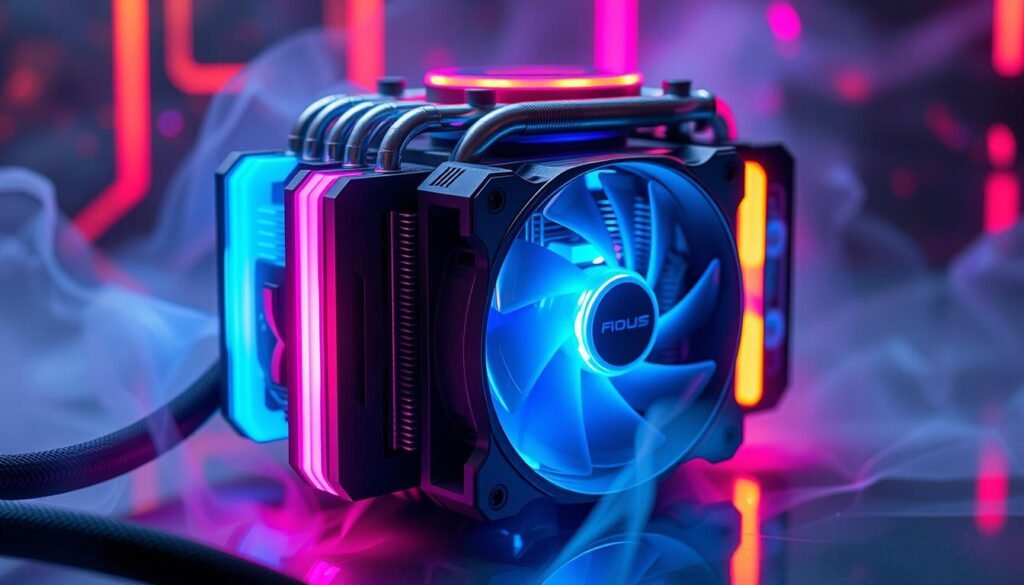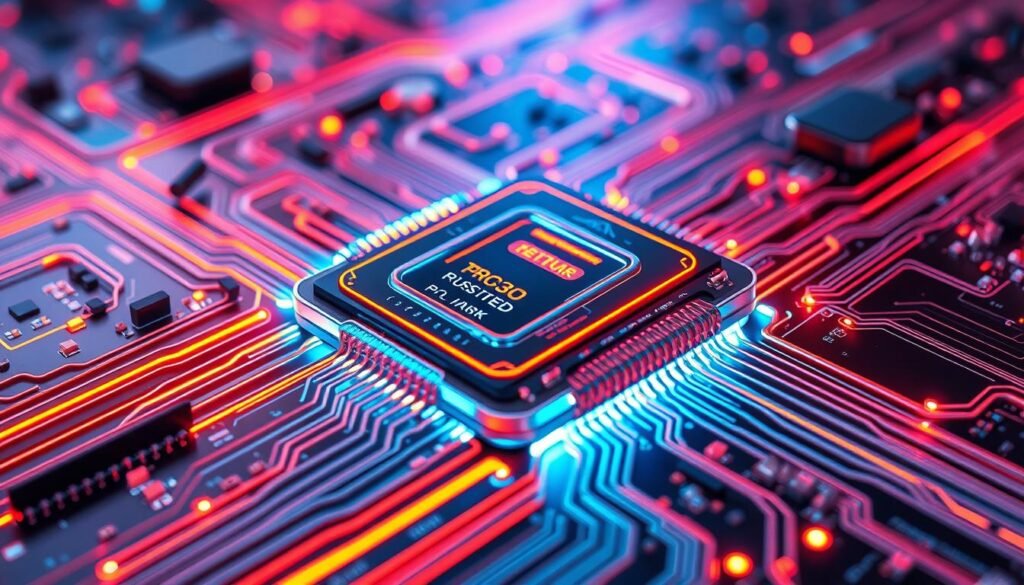Intel’s 15th generation processors, Arrow Lake, are set to launch in Q4 2024. These chips promise major upgrades over previous models. Built on Intel’s 20A (2nm) process, they offer better efficiency and performance.
The Arrow Lake lineup includes Core Ultra 9, 7, and 5 series processors. They feature a new hybrid core design for improved computing power. These chips also boast enhanced energy efficiency through architectural changes.
Early reports suggest impressive gains for 15th gen chips. They may offer a 40% increase in Instructions Per Cycle (IPC). A 5% clock speed boost and 15% multi-core performance improvement are also expected.
Table of Contents
ToggleKey Takeaways
- Intel’s 15th generation processors, codenamed Arrow Lake, are expected to launch in Q4 2024
- The new chips will be built on Intel’s 20A (2nm) process node, offering enhanced power efficiency and performance
- The Arrow Lake lineup includes Core Ultra 9, 7, and 5 series processors with a new hybrid core design
- Rumored performance improvements include a 40% increase in IPC, 5% clock speed boost, and 15% multi-core performance gain
- The Arrow Lake processors are set to deliver a significant upgrade in computing power and energy efficiency
Introducing Intel’s Arrow Lake Architecture
Intel’s 15th generation “Arrow Lake” processors are set to transform computing. These chips feature a groundbreaking tile-based design, unlike previous generations. This innovative approach allows for greater flexibility and optimization of performance cores and efficiency cores.
Arrow Lake’s foundation is Intel’s advanced 20A process node. This upgrade from 10nm and 14nm nodes promises better power efficiency and performance. Core architecture upgrades and clock speed boosts contribute to these improvements.
New Core Designs and Manufacturing Process
Arrow Lake CPUs will mix performance-focused “P-cores” and power-efficient “E-cores”. P-cores will use the “Lion Cove” architecture, while E-cores employ the “Skymont” design. These changes, along with the 20A process, should deliver significant IPC improvements.
The new design is expected to boost multi-core performance gains. This combination aims to optimize both power and efficiency in Intel’s latest processors.
Enhanced Performance and Efficiency
Rumors suggest Arrow Lake processors will offer 18% better performance per watt. This efficiency boost comes from the tile-based design and advanced 20A process node. Users can expect a significant clock speed boost from the new Intel 15th Gen chips.
The optimized core architectures contribute to an overall multi-core performance uplift. These enhancements promise a notable improvement in computing power and efficiency.
Unlocking Higher Clock Speeds
Intel’s 15th generation Arrow Lake processors may have slightly lower max clock speeds. However, they’ll likely outperform previous chips due to improved instructions per clock (IPC) and multi-core performance.
Rumors suggest top-end Core Ultra 9 models could reach 5.7 GHz. They may also see a 40% IPC boost and 15% multi-core performance increase. These improvements should deliver impressive gains, especially in demanding tasks.
The exact specs for Core Ultra 9, 7, and 5 series aren’t known yet. But these chips are set to raise the bar for desktop computing performance.
Rumored IPC and Multi-Core Improvements
Reports indicate Arrow Lake’s Lion Cove performance cores may see a 14% IPC improvement. The Skymont efficiency cores could experience a 38% IPC increase.
These advancements, along with more cores and higher clock speeds, should boost multi-core performance. This makes 15th gen Intel processors attractive for power users and enthusiasts.
| Processor | Expected Clock Speed | IPC Improvement | Multi-Core Performance |
|---|---|---|---|
| Core Ultra 9 285K | Up to 5.7 GHz | 40% | 15% |
| Core Ultra 7 265K | Up to 5.5 GHz | 35% | 12% |
| Core Ultra 5 245K | Up to 5.3 GHz | 30% | 10% |
“The 15th gen Intel Arrow Lake processors are set to redefine desktop computing performance, delivering a potent combination of higher clock speeds, increased IPC, and improved multi-core capabilities.”
Hybrid Core Configuration
Intel’s upcoming 15th generation Arrow Lake processors will feature a hybrid core setup. They’ll combine high-performance “P-cores” with power-efficient “E-cores”. This approach balances computing power and energy efficiency, similar to recent mobile processors.
P-cores handle demanding tasks, while E-cores manage background processes. This design offers great performance without sacrificing battery life or thermal management. Arrow Lake models are expected to have more P-cores and E-cores than previous generations.
Leveraging Hybrid Architecture
The hybrid core design in Intel’s 15th generation processors balances performance and power efficiency. It allows dynamic resource allocation for different tasks. P-cores tackle intensive workloads, while E-cores handle less demanding tasks.
This hybrid core design aims to provide exceptional computing power and extended battery life. Users can enjoy a seamless experience with the best of both worlds.
“The hybrid core configuration in Intel’s 15th gen processors is a game-changer, allowing users to experience the perfect balance of performance and power efficiency.”
Intel’s implementation of hybrid core architecture in Arrow Lake processors is groundbreaking. It’s set to shape the future of computing performance and power efficiency.
Upgraded Integrated Graphics
Intel’s 15th generation Arrow Lake processors are set to revolutionize integrated graphics. These chips may include up to 32 Xe graphics cores. This upgrade promises significant improvements for various users.
Casual gamers can expect a more enjoyable experience with enhanced graphics performance. Content creators will benefit from improved 4K video playback and multi-display support.
The new Xe graphics core offers efficient solutions for everyday computing tasks. Users may find it capable for web browsing and light photo editing. This power-efficient design could be an attractive alternative to separate GPUs.
Intel’s 15th gen Arrow Lake processors aim to elevate user experiences across the board. The enhanced integrated graphics cater to diverse needs, from gaming to content creation. This advancement showcases Intel’s dedication to versatile computing solutions.
intel 15th gen: The Next Generation of Computing
Intel’s 15th generation processors, Arrow Lake, mark a huge leap in computing power. These chips use Intel’s advanced 20A (2nm) process for compact, efficient design. Their core architectures have been revamped with hybrid high-performance and power-efficient cores.
Reports suggest a 40% boost in multi-core performance over the previous generation. There’s also a potential 5% clock speed increase and 15% improvement in overall multi-core performance. These advancements show Intel’s dedication to delivering exceptional computing experiences.
The 15th gen CPUs feature upgraded integrated graphics and support for DDR5 and PCIe 5.0. These improvements cement Intel’s position as an industry leader. The new processors are set to redefine desktop, mobile, and enterprise computing capabilities.
| Key Improvements | Estimated Performance Gain |
|---|---|
| Multi-core Performance | 40% Increase |
| Clock Speed | 5% Boost |
| Overall Multi-core Performance | 15% Improvement |
| Integrated Graphics | 220% to 240% Increase |
Intel’s 15th generation processors are set to revolutionize computing. They promise unmatched performance, efficiency, and an enhanced user experience. The future of computing is bright with these groundbreaking advancements.
Memory and Connectivity Advancements
Intel’s 15th Gen Arrow Lake processors are set to launch around October 2024. These new chips promise major upgrades in memory and connectivity features.
Faster DDR5 RAM and PCIe 5.0 Support
Arrow Lake will support DDR5 memory with speeds up to DDR5-6400. This upgrade offers a big boost in bandwidth and data transfer speeds over DDR4 memory.
The new CPUs are expected to have lower memory latency. This means faster app loading, smoother multitasking, and better performance in memory-heavy tasks.
Arrow Lake processors will also support the new PCIe 5.0 standard. This provides more bandwidth for fast storage devices and other peripherals.
These memory and connectivity upgrades will boost system performance. Users will see benefits in gaming, content creation, and professional tasks.

| Feature | Intel 14th Gen | Intel 15th Gen Arrow Lake |
|---|---|---|
| Memory Support | DDR4 | DDR5-6400 |
| Memory Bandwidth | Up to 3,200 MT/s | Up to 6,400 MT/s |
| PCIe Interface | PCIe 4.0 | PCIe 5.0 |
| Memory Latency | Higher | Lower |
| Multitasking Performance | Good | Improved |
“These advancements in memory and connectivity will help users maximize the potential of their computing systems, whether they’re gaming, creating content, or tackling demanding professional tasks.”
AI Integration and Accelerators
Intel’s 15th generation Arrow Lake processors will change how we use AI in computing. These CPUs will have dedicated AI accelerators. They’ll enhance machine learning and intelligent processing within the processors.
The AI hardware will power various applications. This includes better language processing and faster image recognition. It will also improve voice commands and software suggestions.
Users in video editing, gaming, and content creation will benefit from these AI features. Intel’s goal is to make AI more accessible in everyday computing tasks.
This move meets the growing demand for smart, efficient computing solutions. It handles the complexity of modern workloads without specialized hardware.
Intel’s AI integration shows their commitment to innovation. It delivers cutting-edge technology for users. This empowers new levels of productivity, creativity, and entertainment.
As AI transforms the industry, Intel’s capabilities will shape computing’s future. Their advancements will impact both personal and professional use.
“The integration of AI accelerators in Intel’s 15th gen CPUs marks a significant step forward in democratizing advanced AI capabilities, making them more accessible and seamlessly integrated into everyday computing experiences.”
Platform and Compatibility Changes
Intel’s 15th generation Arrow Lake processors will require a new socket and chipset. These CPUs will use the LGA 1851 socket, replacing the LGA 1700 used in current generations.
The LGA 1851 socket enhances power delivery and signal integrity. However, it’s incompatible with existing LGA 1700 motherboards. Users upgrading to Arrow Lake will need new motherboards supporting the LGA 1851 socket.
New Motherboards and Chipsets
Intel’s 15th generation platform introduces new chipsets with exciting features. These include support for faster DDR5 memory and PCIe 5.0 connectivity. Thunderbolt 4 technology may also be included.
The new platform offers increased memory and storage bandwidth. It also brings advancements in connectivity. These improvements will benefit users seeking maximum computing performance.
The 15th gen platform requires investment in new hardware. However, it provides a compelling upgrade path for future-proofing systems. This combination of new socket, chipset, and features promises an elevated computing experience.
| Feature | 12th/13th Gen Intel | 15th Gen Intel (Arrow Lake) |
|---|---|---|
| Socket | LGA 1700 | LGA 1851 |
| Chipset | 600 Series | New Chipset Generation |
| Memory | DDR4/DDR5 | DDR5 |
| PCIe | PCIe 5.0 | PCIe 5.0 |
| Thunderbolt | Thunderbolt 4 | Thunderbolt 4 |
Thermal Design and Cooling Considerations
Intel’s 15th generation Arrow Lake processors require careful attention to thermal design and cooling. The new CPUs have a higher maximum junction temperature of 105 degrees Celsius. This is up from 100 degrees in the previous generation.
The increased temperature ceiling may result from improved efficiency in the 20A manufacturing process. However, these chips will still need robust cooling solutions. This is due to their higher power draw and heat output.
Users might need to upgrade their CPU coolers or explore liquid cooling options. This is especially true for top-tier Core Ultra 9 models. Proper cooling ensures system stability and peak performance.
The right cooling setup is crucial for maximizing 15th gen Intel-powered systems. High-performance air coolers or advanced liquid cooling solutions are worth considering. Careful attention to tdp, cooling requirements, and heat output is key.
These factors affect system stability and performance maintenance. Addressing them helps unlock the full potential of these next-generation processors.
| Cooling Solution | Suitable for | Pros | Cons |
|---|---|---|---|
| Air Cooling | Lower to mid-range 15th gen Intel CPUs |
|
|
| Liquid Cooling | High-end 15th gen Intel CPUs, including Core Ultra 9 |
|
|

“Ensuring the right cooling setup will be crucial for those looking to maximize the potential of their 15th gen Intel-powered systems.”
Early Benchmarks and Performance Expectations
Intel’s 15th Gen Arrow Lake processors are causing a stir among tech fans. Early benchmarks hint at big gains in single-core and multi-core tasks. These new CPUs might give AMD’s latest Ryzen chips a run for their money.
The top-tier Core Ultra 9 model is expected to excel in gaming and content creation. Geekbench and 3DMark results suggest faster system response and better handling of tough tasks. This includes video editing and 3D rendering.
The 15th Gen design focuses on power efficiency. This means better performance-per-watt, giving users more power without using much more energy. While final results are pending, early signs point to a big leap in Intel’s abilities.
Power users and tech lovers are eagerly awaiting these new processors. They promise a clear boost in system performance and efficiency. As Intel and AMD compete, we can expect more cutting-edge benchmarks and performance gains soon.
“The 15th Gen Intel processors are set to deliver a significant leap in performance, challenging the current market leaders and offering a compelling upgrade for power users.”
Competitive Landscape and Market Impact
Intel’s 15th generation Arrow Lake processors will intensify the battle for high-performance computing supremacy. AMD’s Ryzen 9000 series is also set to debut soon. Users will have a tough choice between these two rivals’ flagship offerings.
The 15th generation Intel chips are expected to boost computing power and energy efficiency. This could help Intel regain ground against AMD’s recent market successes. The Ryzen 9000 lineup is also anticipated to offer significant advancements.
Users will have access to powerful CPUs, regardless of brand preference. The 15th generation Intel processors must deliver a next-level computing experience. This is crucial to maintain their market position and appeal to various users.
| Metric | Intel 15th Gen | AMD Ryzen 9000 |
|---|---|---|
| Estimated Release Timeframe | Late 2024 | Late 2023 |
| Core Configuration | 8 P-cores, up to 16 E-cores | Up to 16 cores |
| Memory Support | DDR5-6400 | DDR5-6400 |
| Performance Increase | 15% multi-core, 5% single-core | Not yet reported |
| Process Node | Intel 20A (2nm equivalent) | TSMC 5nm |
The intel vs amd battle is heating up in the CPU market. Both the ryzen 9000 series and Intel’s 15th generation will push performance limits. They’ll also boost power efficiency to new heights.
Consumers and pros face a tough choice for their next upgrade considerations. The market positioning of these chips will play a key role in their success.
“The upcoming 15th generation Intel processors will need to truly excel in order to maintain their position in the high-performance computing market against the strong competition from AMD’s Ryzen 9000 series.”
Conclusion
Intel’s 15th generation Arrow Lake processors are a major step forward. These new chips offer many improvements, including a move to 20A (2nm) manufacturing. They feature a redesigned hybrid core and better performance across the board.
The 15th gen CPUs will have improved integrated graphics and AI capabilities. They’ll also support DDR5 memory and PCIe 5.0 connectivity. These advancements will deliver a next-level computing experience.
Users may need to invest in new hardware due to the LGA 1851 socket. However, the benefits of these processors could outweigh the costs. Intel must prove their chips excel in performance and efficiency.
Arrow Lake processors aim to provide advanced computing solutions for various needs. They focus on performance, efficiency, and cutting-edge features. These chips could set new standards for desktop and mobile computing in the future.
FAQ
What are the key features of Intel’s 15th generation Arrow Lake processors?
Intel’s 15th gen Arrow Lake processors use advanced 20A (2nm) manufacturing. They feature a new hybrid core design with “P-cores” and “E-cores”. These chips offer major improvements in IPC, clock speeds, and multi-core performance.
How does the hybrid core design in Intel’s 15th gen processors work?
Arrow Lake processors combine high-performance “P-cores” with power-efficient “E-cores”. P-cores handle demanding tasks, while E-cores manage background processes. This design balances raw performance and power efficiency.
What kind of performance gains can we expect from Intel’s 15th gen CPUs?
Rumored improvements include a 40% increase in Instructions Per Cycle (IPC). There’s also a 5% clock speed boost and 15% better multi-core performance. These upgrades make Arrow Lake a significant step up from previous generations.
What advancements are expected in the integrated graphics of Intel’s 15th gen chips?
Arrow Lake processors may feature up to 32 Xe graphics cores. This boost should improve gaming performance and 4K video playback. It may also offer better support for multiple displays.
How will Intel’s 15th gen processors affect memory and connectivity capabilities?
Arrow Lake chips will support DDR5 RAM with speeds up to DDR5-6400. This offers increased bandwidth and lower latency. They’ll also support PCIe 5.0, providing greater bandwidth for high-speed storage and peripherals.
What kind of AI capabilities will the 15th gen Intel processors have?
Arrow Lake processors will have integrated AI accelerators. These enable enhanced machine learning and intelligent processing within the CPUs. This will power better natural language processing, faster image recognition, and smarter productivity software.
What platform changes will come with Intel’s 15th gen processors?
Arrow Lake processors need a new LGA 1851 socket. Users must upgrade their motherboards for these new chips. The platform will introduce new chipsets supporting faster DDR5 memory and PCIe 5.0.
What kind of cooling requirements will the 15th gen Intel chips have?
Arrow Lake processors may have a higher maximum junction temperature of 105°C. This is up from 100°C in the 14th gen. Users might need to upgrade CPU coolers, especially for top-end Core Ultra 9 models.
How do the early benchmarks for Intel’s 15th gen processors look?
Early leaked benchmarks show significant improvements over 14th gen chips. The flagship Core Ultra 9 model may have impressive gains in single-core and multi-core workloads. This could pose a strong challenge to AMD’s latest Ryzen offerings.
How will Intel’s 15th gen processors compete in the high-performance computing market?
Arrow Lake processors will intensify competition between Intel and AMD. These chips are expected to deliver major improvements in computing power and energy efficiency. This could help Intel regain ground against AMD’s recent successes.

